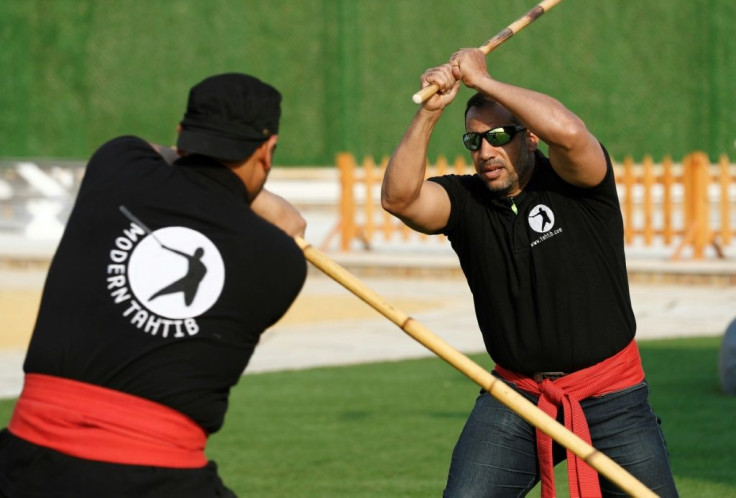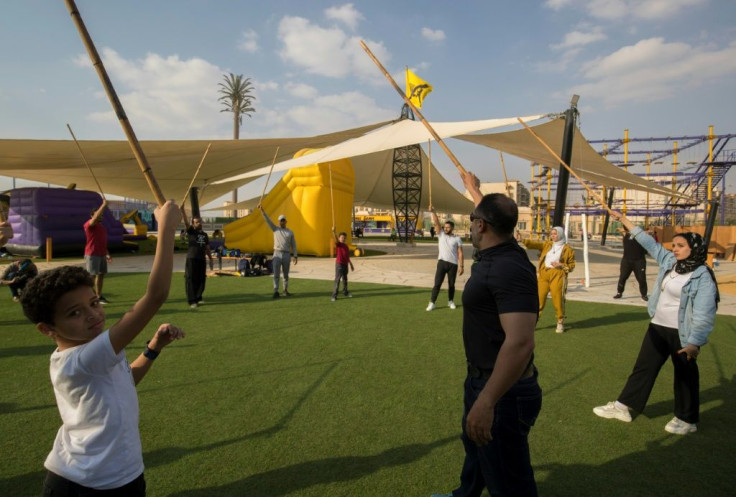Ancient Egypt Martial Art Enthusiasts Eye Olympic Status
Egypt's tradition of tahtib (stick fighting), popular at festivities and dating back at least 5,000 years, has become a modern martial art that enthusiasts hope will eventually make it to the Olympics.
French-Egyptian Adel Paul Boulad, who for some 15 years has been the driving force behind modern tahtib, calls the push a "unifying project" and a "cultural revolution".
The modern practice "is an updated sports version of a multi-millennial art", said the 69-year-old martial arts teacher.
"It is a sporting practice that is codified, structured... and which spans the entire history of Egypt," he told AFP.
In traditional tahtib, popular in Egypt's rural south, two men perform a dance while wielding bamboo-like rods, in a face-off somewhat resembling a fencing duel.
Folk musicians with loud drums accompany the performance, which is popular at weddings and festivities, and pump up the crowd encircling the men, who don traditional galabeya robes.
The UN cultural agency UNESCO in 2016 listed the martial art as "intangible cultural heritage of humanity".

France-based Boulad, who was also behind tahtib's UNESCO candidacy, formalised its intricate moves and broke it down to 12 forms -- the equivalent of katas in Japanese martial arts.
The "secrets of combat" were inscribed in stone on the walls of temples and tombs of ancient Egypt's Old Kingdom (2,700 to 2,200 BC) until the arrival of the Greeks, who conquered the North African country around 300 BC.
Boulad, who is also a business coach, wants to see tahtib included as a combat sport at the Olympics in the coming years.
Wearing a red belt with three tips -- reminiscent of the style of ancient Egyptian warriors -- and black outfits, competitors wield a 1.3-metre rattan stick.
Unlike traditional tahtib, women can participate in its modern version.

With exhibitions, notably at the International Martial Arts Festival in Paris in 2016, modern tahtib already has attracted followers internationally, but is still trying to gain a foothold in Egypt.
Boulad said he had given himself two to three years, with the help of private financing, to create "regional centres" across the world for spreading the sport further, including in Canada, Colombia and Hungary.
"I say to Egyptians, get moving, otherwise tahtib will go to the Olympics without an Egyptian team representing it," he said.
In Cairo's upmarket eastern suburb of Rehab, a leisure park welcomes the first enthusiastic Egyptian instructors trained by Boulad, and their eager students.
Nasser Refai, 44, a physical education teacher and one of the trainers, said the Egyptian fighting style inherited from the time of the pharaohs was a "treasure".
"It's something we have to keep. Like any art form, if we don't practice, we lose it," added Refai, known affectionately as Captain Nasser to his students.
He and his associates have slowly started attracting young local admirers of the sport via social media.
"It's not just about fighting, it's about respecting and changing yourself," he told AFP, adding that it would be his "dream" to see tahtib recognised as an Olympic sport.
Stick in hand and wearing a headscarf, Jasmine Anwar, 25, is keenly taking part in her first training session.
"I will continue. I won't stop at just knowing how to hold the stick," the schoolteacher said.
New recruit, Jouba Ayoub Mohammed, a 27-year-old graphic designer, expressed interest in promoting the sport to others of his generation.
But "we must first let Egyptians know that tahtib is not a folk dance that is performed only at weddings and other cultural events," he said.
"It's a part of ancient Egyptian history."
© Copyright AFP 2024. All rights reserved.





















